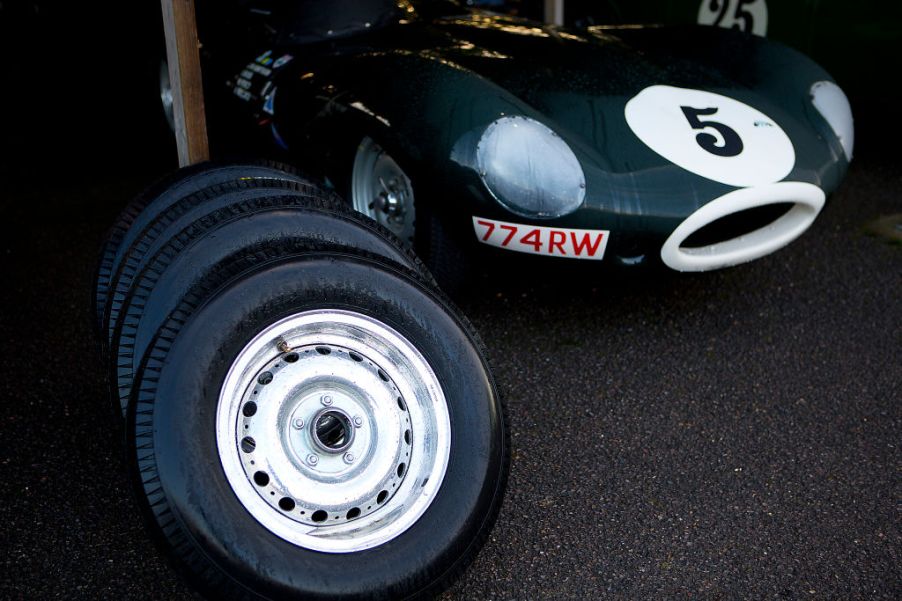
Why You Can’t Just Put Modern Tires on a Classic Car
It’s possible to take some of the inconvenience out of driving a classic car. You can give it modern infotainment, or even swap out the powertrain for an electric one. However, automotive tech has evolved in more areas than just safety features, brakes, and engine design. Your car’s tires have also been improved over the decades. But giving a classic vehicle modern tires isn’t as simple as mounting on fresh rubber.
Modern tires vs. classic ones
Classic cars, Hemmings reports, tend to ride on bias-ply tires. Inside the rubber are numerous cords, which are overlapped diagonally to each other. These layers are called plies, Four Wheeler explains, hence the name. The plies are attached to the beads, which is how the force gets transferred and the car turns.
Today, cars use radial tires. While bias-ply cords run diagonally between beads, in a radial tire they’re at 90° angles. In addition, Hagerty reports, these cords are made of steel, not nylon. Radial tires also come with additional steel belts placed between the plies and the outer surface. This change in design has several benefits.

For one, as Michelin explains, bias-ply tires don’t flex as well as modern ones. The overlapped cords make the sidewalls very stiff, Revzilla explains. This makes ride quality worse.

And because the tread and sidewalls are connected, since the sidewalls don’t flex, the tread won’t either. Meaning, the tire can’t conform to the road as well, which makes handling worse. In addition, the nylon cords don’t dissipate heat well, meaning you lose grip more easily.
In contrast, the steel belts in modern radial tires separate sidewall and tread flex. So, you get a comfy ride without losing traction. In addition, the belts make the contact patch wider, further improving handling. Plus, Road & Track reports, new additives make the rubber itself even grippier. The extra surface area also means manufacturers can add rain siping to funnel water away for better wet-weather handling.
However, although the extra grip is beneficial, it can also be problematic for classic cars.
New rubber, new problems
YouTube channel ISSIMI’s hosts Jason Cammisa and Derek Tam-Scott recently discussed their respective automotive hero cars. Specifically, which ones lived up to their reputations, and which ones didn’t. And in the video below (warning: spicy language), Cammisa discusses the famous BMW 3.0 CSL, aka ‘the Batmobile.’
Named for its racing aero trim, specifically the large rear wing, the 3.0 CSL was a true homologation special, Silodrome reports. And besides the wing, the CSL also weighed about 440 pounds less than the standard CS. Part of this, Cammisa explains, was due to thinner sheet-metal. But this caused a problem. The car flexed so much, if you installed tires that were too grippy, the doors would sometimes fly open during cornering.
That’s the biggest problem, Hemmings explains, with putting modern tires on a classic car. Even if they’re the correct size, the extra grip puts more strain on the car’s suspension and chassis components. And even on the wheels themselves, SEMA reports. Modern tires don’t distribute stress to their wheels as bias-ply tires did. So, if you try mounting a radial tire on an old wheel, the wheel might crack or fail completely.
That’s why, R&T reports, vintage race cars slide around so much. Bias-ply tires, by their design, don’t grip very well. However, the car engineers knew that and designed their vehicles around that limitation.
Luckily, there are ways around these issues.
Upgrading a classic car’s rubber properly
The simplest solution is to upgrade the classic car’s suspension and wheels to match. Although not exactly ‘original’, the car will then have some measure of modern refinement and handling. Some manufacturers, though, do offer some additional support in the tire department.
Hagerty reports that, when Mazda decided to start restoring NA Miatas, the process also included new tires. The car’s original Bridgestones used a different rubber formula and tread design that sacrificed the maximum grip for the predictability. To recreate the original intended experience, Bridgestone remade the original design using a museum-kept Miata as the starting point.

Porsche, Petrolicious reports, also helps its classic car clients with their tire needs. The German automaker tests and helps develop designs that combine modern materials and driving behavior with classic looks. And because Porsche knows all its vehicles specific engineering limits, the modern tires won’t overwhelm or break the car’s parts.
Follow more updates from MotorBiscuit on our Facebook page.


